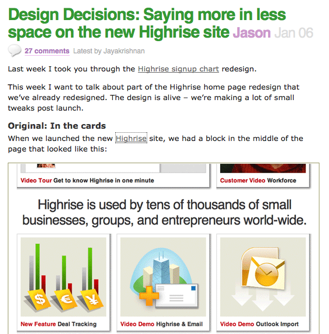Why I like 37signals Design Decision Posts
I really like the design decisions blog posts at 37signals. A recent example: Design Decisions: Saying more in less space on the new Highrise site, in which a designer (in this case Jason) discusses how he made changes to a certain design. He shows the initial design, lays out the rationale for change, and then […]
I really like the design decisions blog posts at 37signals. A recent example: Design Decisions: Saying more in less space on the new Highrise site, in which a designer (in this case Jason) discusses how he made changes to a certain design. He shows the initial design, lays out the rationale for change, and then shows the changes. The structure of the post couldn’t be more simple.
But the reason why I like the posts isn’t because of the content (although it’s good). I really like the posts because they do it and nobody else does.
Now think about this. 37signals is a well-known company in web design circles and have a solid reputation as designers, and they’re releasing a beta design on their site, talking about its shortcomings on their blog. They’re designing in public. They have no need to do this. They’re risking their reputation here. Can you imagine if their design is less than perfect? Imagine what people will say? Holy cannoli…people might actually find something not-so-good about what they made.
In fact, it’s happening already. Just read down through the comments…many folks give their honest feedback about what’s wrong with the site. And you know what? In some cases the commenters are right. For example, several people are complaining that the headers in the page are getting squeezed by the content around them. I agree…I can feel myself not wanting to read them.
But those are minor details and will be taken care of eventually. Look at the overall outcome. The page will be better, and that’s the only thing that matters. If the goal was to protect the ego of the designers, they wouldn’t do this. If, on the other hand, your goal is to get the best design possible this is one way to get closer.
If you sweat design, if you want the best design you can possibly get, you want feedback all the time. You want criticism. You want people to push you to make things better. It’s a hard pill to swallow. But even the most attentive designers miss things.
So while the vast majority of designers sit back and hope their designs are solid, deciding not to talk about them, those who put themselves on the line publicly will end up with the best design. Sure, they take a hit on their ego…but that will always be reparable later when the design is bringing in the love.
It also shows that the team cares about the experience of their customers. If it’s apparent that they sweat the details of things like the number of pixels in a specific screen element, that transmits a powerful message to their audience. We care. We’re working on it all the time. You’re in safe hands. Etc.
It also is great publicity for their software. Having read 37signals for a long time, this is likely one goal of the posts, and I bet that these types of posts are among their most read. I know from my own experience that people love hearing about design rationale. My post Digg’s Design Dilemma, in which I look at how the design of the Digg site actually promoted gaming, remains a well-read post even though I wrote it two and a half years ago. And when I give talks people really like slides like this: How Social is Amazon?.
I also like the design decisions blog posts because they are perfectly aligned within a larger strategy…37signals is working at several levels to make their product better, show users they care, and grow publicity for their offering.
So, I wish more designers did this. I wish I knew what more designers thought. I wish designers would explain their rationale more often. I’m positive that 37signals takes a much different approach than many other designers. I know lots of folks who would design these pages in a completely different way. But you know what? Most aren’t talking about it on their blog, sharing their process, or going through this public ritual.
I think that design education in general needs to be more public. Design shouldn’t be mysterious! It should be everywhere, part of the culture, part of daily life. Kids should be designing in school. Design should be part of the curriculum. We should be soaked in it.
Who doesn’t like hearing about how things were made for them?
